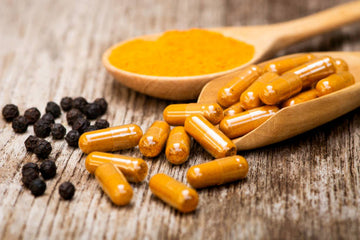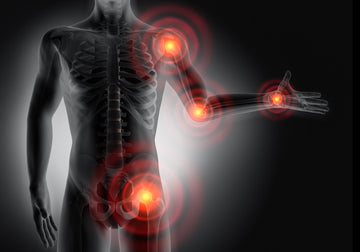Does your morning start with stiff, achy joints that make even simple tasks like buttoning a shirt feel challenging? You're not alone. Millions of people wake up thinking "why do my joints hurt?" and search for joint pain relief that actually works.
Joint pain can strike anywhere in your body, from your knees to your fingers, making everyday activities feel like a major challenge. While the cause of joint pain varies - it could be arthritis, an old injury, or even your daily activities - the impact on your life is very real. The good news? Whether you're dealing with occasional aches or ongoing discomfort, there are many ways to feel better.
In this guide, we'll explore why joints hurt, what you can do about it, and how to find the right joint pain relief for your specific situation. Let's start by understanding what's really going on in your joints.
Types of joint pain by location
Your body has over 360 joints, and each type can experience pain differently. Think of your joints like hinges on a door - some are small like the ones in your fingers (joints in fingers), while others are large and complex like your hip joint or knee joint.
When you have pain, pinpointing exactly where it hurts helps guide treatment. Some people might feel sharp pain in a single joint, like a sore thumb joint or ankle joint pain. Others experience discomfort in multiple areas, which doctors call multiple joint pain. The location of your pain often provides important clues about what's causing it and how to find relief.
Let's explore the most common locations where joint pain occurs, starting with the upper body and working our way down.
Upper body joints
Let's start with your hands, since they contain some of the most frequently used joints in your body. Have you ever noticed how much you use your fingers and thumbs in a single day? From typing on your phone to opening jars, these small joints do a lot of work.
Hand and finger joints
Many people experience finger joint pain when bending their fingers or notice swollen finger joints. This can be especially worrying when you don't have arthritis but still see swelling. The most commonly affected areas are the index finger joint and middle finger joints, which we use for gripping and detailed tasks. Sometimes just one swollen finger joint might appear, which could signal different conditions than when multiple joints are affected.
Thumb joint pain
Your thumb is particularly vulnerable to joint problems because it's used in almost every hand movement. Thumb joint pain can make simple tasks like turning a key or holding a cup challenging. The thumb has several key joints, including the MCP joint at the base and the IP joint near the tip. Many people develop arthritis in the thumb joint over time, especially at the base where it connects to the wrist.
Shoulder and upper arm
Moving up to larger joints, shoulder joint pain affects many people, especially during activities like reaching or lifting. A common issue is AC joint arthritis, which occurs where your collarbone meets your shoulder blade (the acromioclavicular joint). This can cause pain at the top of your shoulder. Arm joint pain might also connect to shoulder problems, as these joints work together in many movements.
Lower body joints
Your lower body joints carry most of your weight and help you stay mobile throughout the day. Let's look at some common problem areas and what they mean for your daily life.
Hip and SI joint issues
Hip joint pain can significantly affect how you move, especially when it appears on one side. Left hip joint pain, for example, might change how you walk or make it difficult to find a comfortable sleeping position. One frequently overlooked area is the SI joint (sacroiliac joint), where your spine meets your pelvis. SI joint dysfunction can cause pain in your lower back and hips, making even simple movements uncomfortable. The good news is that SI joint pain treatment has advanced significantly, with many options for SI joint pain relief available. For those dealing with chronic SI joint pain, a combination of treatments often works best.
Toe and foot concerns
Your feet bear the weight of your entire body, and the joints in your toes work hard with every step. Big toe joint pain is particularly common, especially when walking or during activities. You might notice big toe joint pain and swelling after being on your feet all day. Some people experience pain under the big toe joint, while others feel pain on top of the big toe joint. The medical term for this area is the metatarsophalangeal joint, and problems here can affect your entire walking pattern. Foot joint pain often develops gradually, but addressing it early can prevent bigger problems later.
Common conditions and symptoms
Joint problems don't always stay in one place. Let's look at different patterns of joint pain and what they might mean for your health.
Multiple joint involvement
Sometimes pain can affect several joints at once, which doctors call multiple joint pain. You might notice multiple joint pain without swelling, or the pain might move from joint to joint. This pattern, called migratory joint pain, can be especially frustrating because it's hard to predict which joint will hurt next.
Some people experience joint pain all over body, while others have random joint pain that comes and goes. An interesting pattern is joint pain on one side of body, which might signal different conditions than pain affecting both sides.
Time-related symptoms
Have you noticed your joints hurt more at certain times? Joint pain at night is a common complaint that can interfere with sleep. Some people experience joint and muscle pain at night that eases during the day. Morning stiffness that improves with movement is another typical pattern. Understanding when your pain occurs can help identify the underlying cause and guide treatment.
Associated symptoms
Joint pain rarely travels alone. Many people experience joint pain and fatigue together, making everyday tasks doubly challenging. The combination of muscle and joint pain with fatigue can be particularly draining. Some deal with extreme fatigue muscle weakness joint pain all at once, which can seriously impact their quality of life.
Joint pain and weakness might also occur together, making it harder to grip objects or maintain balance. Muscle weakness and joint pain often signal that your body's support system needs attention.
Treatment approaches
Just as there are many types of joint pain, there are many ways to find relief. Let's explore your options, from medical treatments to natural solutions.
Medical interventions
1. Traditional treatments
When you seek joint pain treatment, your healthcare provider might start with conventional approaches. Joint inflammation treatment often begins with over-the-counter medications that reduce swelling and ease pain.
For specific conditions like facet joint syndrome, your doctor might recommend targeted therapies. Elbow joint pain treatment could involve a combination of medication and physical therapy, while knee joint pain relief might require different approaches depending on the cause.
2. Specialized procedures
Medical science keeps advancing, and new treatment for facet joint pain includes innovative procedures. If you have a facet joint injury, your doctor might recommend specific treatments like injections or specialized physical therapy. SI joint dysfunction treatment has also improved, with options ranging from targeted exercises to minimally invasive procedures. The goal of all joint pain relief techniques is to help you move more comfortably and return to your daily activities.
Natural and alternative solutions
1. Lifestyle modifications
Many people find success with natural remedies for joint pain. For women experiencing menopause joint pain, natural remedies can be particularly helpful when combined with other treatments.
Regular exercise, though sometimes challenging when you're in pain, often helps strengthen the muscles supporting your joints. Weight management also plays a crucial role, as extra pounds can put additional stress on your joints.
2. Supplementation
One promising option for joint health support is OurJrney's Nano Turmeric Curcumin Powder. This innovative supplement uses nanotechnology to improve absorption of turmeric, a natural anti-inflammatory ingredient. The easy-to-mix powder comes in convenient packets with natural mango flavor, making it simple to add to your daily routine.
Scientific research supports turmeric's traditional benefits for joint health and immune system function.
Self-care strategies
Finding the best thing for joint pain often involves combining several approaches. Many people discover that joint relief comes from a mix of:
-
Regular gentle movement
-
Hot and cold therapy
-
Proper rest and recovery
-
Stress management
-
Healthy eating habits
-
Appropriate supplementation
Prevention and long-term management
Taking care of your joints isn't just about treating pain when it happens – it's about preventing problems and maintaining joint health over time. Let's explore how you can protect your joints for years to come.
Understanding Risk Factors
Several things can make you more likely to develop joint problems:
-
Age: As you get older, your joints naturally experience more wear and tear
-
Weight: Extra pounds put additional stress on weight-bearing joints
-
Previous injuries: Old injuries can lead to future joint issues
-
Repetitive movements: Doing the same motions over and over can strain your joints
-
Family history: Some joint conditions run in families
-
Certain medical conditions: Problems like diabetes can affect joint health
Daily prevention strategies
Small changes in your daily routine can make a big difference in protecting your joints:
-
Use proper posture when sitting and standing
-
Take breaks during repetitive activities
-
Lift heavy objects correctly, using your legs instead of your back
-
Maintain a healthy weight through diet and exercise
-
Stay active with low-impact exercises like swimming or cycling
-
Warm up before physical activity
-
Wear supportive shoes and use proper equipment during sports
When to seek medical help
Don't wait too long to get help if you notice:
-
Joint pain that lasts more than a few days
-
Sudden swelling or redness
-
Joints that are hot to the touch
-
Difficulty moving a joint
-
Pain that interferes with daily activities
-
Unexplained weight loss along with joint pain
Conclusion
Living with joint pain can feel overwhelming, but you have more control over your joint health than you might think. Whether you're dealing with a sore thumb joint, experiencing hip joint pain, or managing multiple joint pain, there's always hope for improvement. Remember that finding the right joint pain relief often takes time and may require trying different approaches.
Here are your key takeaways:
-
Pay attention to when and where your joints hurt - this information helps guide treatment
-
Don't wait too long to seek help if pain persists or worsens
-
Consider a combination of treatments, from traditional medicine to natural remedies like OurJrney's Nano Turmeric Curcumin Powder
-
Make small, consistent changes in your daily habits to protect your joints
-
Stay active with joint-friendly exercises
-
Work with healthcare providers to create a personalized treatment plan
Reference:
- Wanruchada Katchamart, Pongthorn Narongroeknawin, Parawee Chevaisrakul, Pornchai Dechanuwong, Ajanee Mahakkanukrauh, Nuntana Kasitanon, Rattapol Pakchotanon, Kittiwan Sumethkul, Parichat Ueareewongsa, Sittichai Ukritchon, Thitirat Bhurihirun, Kittikorn Duangkum, Porntip Intapiboon, Samanan Intongkam, Wimol Jangsombatsiri, Kanon Jatuworapruk, Naravadee Kositpesat, Pawinee Leungroongroj, Wiyanoot Lomarat, Chonachan Petcharat, Siriluck Sittivutworapant, Patcharawan Suebmee, Pongchirat Tantayakom, Worakan Tipsing, Paijit Asavatanabodee, Praveena Chiowchanwisawakit, Chingching Foocharoen, Ajchara Koolvisoot, Worawit Louthrenoo, Boonjing Siripaitoon, Kitti Totemchokchyakarn, Tasanee Kitumnuaypong; Thai Rheumatism Association .(2016). Evidence-based recommendations for the diagnosis and management of rheumatoid arthritis for non-rheumatologists: Integrating systematic literature research and expert opinion of the Thai Rheumatism Association
- Finding the Best Joint Pain Relief for You: 24 Treatment Options | Arthritis Foundation
- Ruihuan Du, Gang Xu, Xujue Bai, Zhonghai Li .(2022). Facet Joint Syndrome: Pathophysiology, Diagnosis, and Treatment








